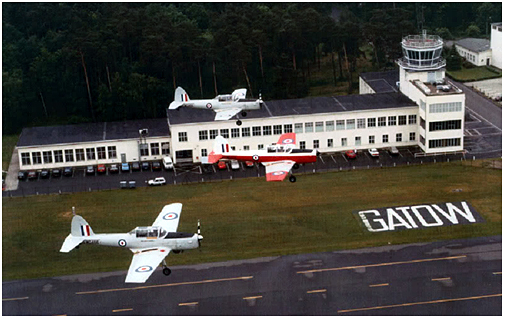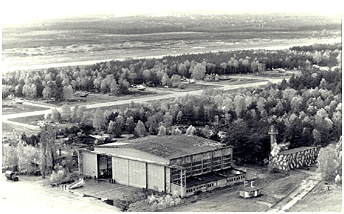
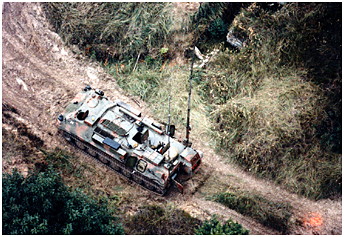 On one particularly hazy Saturday
afternoon, we had managed to become "unsure of our position" and had flown as far as the airfield at Sperenberg which served the headquarters
which we identified by the large number of transport aircraft. Once we realized our mistake we turned north back into the BCZ. Surprisingly
enough there was no reaction either because the Soviets had not noticed us or they had decided to ignore us. Despite everything, the pilots very rarely
got lost even though they had a fairly heavy workload having to pander to the whims of the photographers and hold the aircraft in tight balanced turns
in order to obtain the best photography. However, I have heard mutterings from the back seat when you asked them to hold on 60 degrees of bank to
get a better close-up. Despite our occasional forays into East German airspace, the only complaints about the Chipmunk continued to centre on Schönefeld and the
alleged infringements of the arrival and departure patterns even if it could be proved that we had been nowhere near the airfield. I suspect that this was
a device to let us know that we were being watched and it appeared that the more important the installation overflown, the greater the number of alleged
infringements. It was fortunate that nobody appeared to notice our forays to Kagel.
The normal practice would then be to fly north west to the Soviet helicopter base at Rangsdorf that housed a large repair facility. Occasionally
there was a lot of activity if helicopters were being air tested. On one occasion, probably because the pilots were bored, two attack helicopters
attempted to force down the Chipmunk and the aircraft only escaped by putting on 90 degrees of bank and flying between the approaching 'Hinds'.
Fortunately, this sort of thing did not happen often and all we normally had on our minds was the worry that the single engine kept going.
On one particularly hazy Saturday
afternoon, we had managed to become "unsure of our position" and had flown as far as the airfield at Sperenberg which served the headquarters
which we identified by the large number of transport aircraft. Once we realized our mistake we turned north back into the BCZ. Surprisingly
enough there was no reaction either because the Soviets had not noticed us or they had decided to ignore us. Despite everything, the pilots very rarely
got lost even though they had a fairly heavy workload having to pander to the whims of the photographers and hold the aircraft in tight balanced turns
in order to obtain the best photography. However, I have heard mutterings from the back seat when you asked them to hold on 60 degrees of bank to
get a better close-up. Despite our occasional forays into East German airspace, the only complaints about the Chipmunk continued to centre on Schönefeld and the
alleged infringements of the arrival and departure patterns even if it could be proved that we had been nowhere near the airfield. I suspect that this was
a device to let us know that we were being watched and it appeared that the more important the installation overflown, the greater the number of alleged
infringements. It was fortunate that nobody appeared to notice our forays to Kagel.
The normal practice would then be to fly north west to the Soviet helicopter base at Rangsdorf that housed a large repair facility. Occasionally
there was a lot of activity if helicopters were being air tested. On one occasion, probably because the pilots were bored, two attack helicopters
attempted to force down the Chipmunk and the aircraft only escaped by putting on 90 degrees of bank and flying between the approaching 'Hinds'.
Fortunately, this sort of thing did not happen often and all we normally had on our minds was the worry that the single engine kept going.
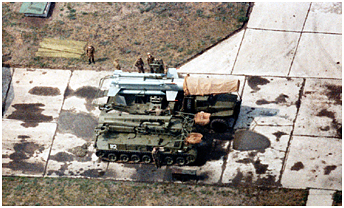
 On our way back, to the south of Potsdam, there was a large army range at Glau which was overlooked by a permanent SA-4 site with its resident
"Pat Hand", tracking radar on a hilltop. Here there were always largescale deployments of engineering equipment that included the normal big
earth movers, pipelayers and bridging equipment as well as more exotic items for mine clearing such as tank mine ploughs and even the Soviet
version of the "Bangalore Torpedo" that fired 100 metre lengths of explosive material to blast paths through minefields.
Before returning to Gatow, we would normally overfly the engineer barracks at Werder where the Soviets appeared to dump all their
unrepairable and obsolete equipment. In the same area to the of west of Gatow on the Berlin Ring, at certain times of the year, the East German
Army would practise for their two military parades of the year in East Berlin before May Day and before the October anniversary of the East German
state [founded on October 7, 1949]. We would inevitably get a preview of all the equipment that was destined to appear on the parade and occasionally glimpses of equipment
that they decided, at the last minute, not to put on show. Finally, on the way back into Gatow, we would check the local ground
ranges at Döberitz where there was normally tank firing. The Soviets were supposed to use low yield weapons, but judging by the noise and the amount
of earth moved by the shells, I doubt if they kept to the agreement. It was always interesting to note on the approach to runway 09 that there were a
great number of mock-ups of NATO equipment that were obviously for teaching recognition to new recruits. The final approach to runway 09 was
also close to an East German Border Guard barracks and training area. There had been some incidents when the Border Guards had taken a shot at
passing aircraft landing at Gatow including a C-130 that had had its main port fuel tanks ruptured by a Kalashnikov round. On our return to the
airfield we would go through the same procedure of taxiing into the hangar before leaving the aircraft with our cameras and films.
These flights went on two or three days every week for the whole time I was in BRIXMIS.
On our way back, to the south of Potsdam, there was a large army range at Glau which was overlooked by a permanent SA-4 site with its resident
"Pat Hand", tracking radar on a hilltop. Here there were always largescale deployments of engineering equipment that included the normal big
earth movers, pipelayers and bridging equipment as well as more exotic items for mine clearing such as tank mine ploughs and even the Soviet
version of the "Bangalore Torpedo" that fired 100 metre lengths of explosive material to blast paths through minefields.
Before returning to Gatow, we would normally overfly the engineer barracks at Werder where the Soviets appeared to dump all their
unrepairable and obsolete equipment. In the same area to the of west of Gatow on the Berlin Ring, at certain times of the year, the East German
Army would practise for their two military parades of the year in East Berlin before May Day and before the October anniversary of the East German
state [founded on October 7, 1949]. We would inevitably get a preview of all the equipment that was destined to appear on the parade and occasionally glimpses of equipment
that they decided, at the last minute, not to put on show. Finally, on the way back into Gatow, we would check the local ground
ranges at Döberitz where there was normally tank firing. The Soviets were supposed to use low yield weapons, but judging by the noise and the amount
of earth moved by the shells, I doubt if they kept to the agreement. It was always interesting to note on the approach to runway 09 that there were a
great number of mock-ups of NATO equipment that were obviously for teaching recognition to new recruits. The final approach to runway 09 was
also close to an East German Border Guard barracks and training area. There had been some incidents when the Border Guards had taken a shot at
passing aircraft landing at Gatow including a C-130 that had had its main port fuel tanks ruptured by a Kalashnikov round. On our return to the
airfield we would go through the same procedure of taxiing into the hangar before leaving the aircraft with our cameras and films.
These flights went on two or three days every week for the whole time I was in BRIXMIS.
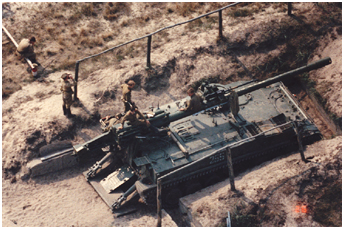
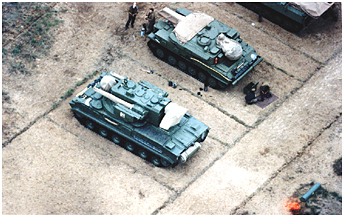 However, as part of a wider intelligence picture, it
should be remembered that this operation went on for almost 35 years without any really serious incidents. There were several near disasters but
on those occasions we got away with it, a case of fortune favouring the foolhardy who should have known better. The operation was so delicate that
the flights had to be sanctioned by the Cabinet Office. In fact, whenever there was a change of government, the flights were suspended in case there
was an incident. There is no question that the flights produced a vast wealth of intelligence material that could not have been obtained in any other way.
I suspect that the Soviet hierarchy, if not actually colluding in the collection of high grade intelligence, turned a blind eye to our activities. The
reason I say this is that many in the Soviet High Command had been in the Great Patriotic War and did not want to repeat the experience in any further
conflict. The only way they could make sure that the West was deterred from making any pre-emptive strike against the Warsaw Pact was to show
them what equipment they had. This would, they hoped, guarantee that any reckless Western politicians who possibly counted on a quick victory
against the Warsaw Pact could be shown hard intelligence that proved that such a course of action would be disastrous.
It would have been simplicity itself to destroy an aircraft and then make a great show of it being a tragic accident. There is no doubt that they knew
exactly who and what was involved in the flights since SERB (Soviet External Relation Branch) often made oblique references to those who participated, about the Chipmunk aircraft
and where it had been seen over installations both inside and allegedly outside the BCZ.
However, as part of a wider intelligence picture, it
should be remembered that this operation went on for almost 35 years without any really serious incidents. There were several near disasters but
on those occasions we got away with it, a case of fortune favouring the foolhardy who should have known better. The operation was so delicate that
the flights had to be sanctioned by the Cabinet Office. In fact, whenever there was a change of government, the flights were suspended in case there
was an incident. There is no question that the flights produced a vast wealth of intelligence material that could not have been obtained in any other way.
I suspect that the Soviet hierarchy, if not actually colluding in the collection of high grade intelligence, turned a blind eye to our activities. The
reason I say this is that many in the Soviet High Command had been in the Great Patriotic War and did not want to repeat the experience in any further
conflict. The only way they could make sure that the West was deterred from making any pre-emptive strike against the Warsaw Pact was to show
them what equipment they had. This would, they hoped, guarantee that any reckless Western politicians who possibly counted on a quick victory
against the Warsaw Pact could be shown hard intelligence that proved that such a course of action would be disastrous.
It would have been simplicity itself to destroy an aircraft and then make a great show of it being a tragic accident. There is no doubt that they knew
exactly who and what was involved in the flights since SERB (Soviet External Relation Branch) often made oblique references to those who participated, about the Chipmunk aircraft
and where it had been seen over installations both inside and allegedly outside the BCZ.
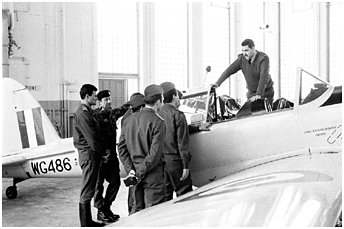
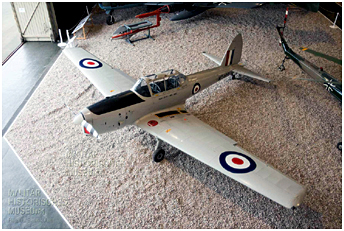 This is probably the reason that the British government allowed this operation to continue for many years, unbeknown to the British public,
despite the fact that they knew that any serious incident could have proved politically damaging both domestically and internationally. However, it
seems that the whole operation actively suited both sides for totally different reasons.
The Chipmunk continued flying in West Berlin on these intelligence collecting trips without mishap until 1990 when the BRIXMIS was finally
disbanded (1), but remained at RAF Gatow as a training aircraft until the station closed on 30 June 1994.
However, this was not the end of the story of
Chipmunks in Berlin. Exhibits were being acquired by the German Authorities for a new museum that would commemorate the presence of the
Allied Forces in West Berlin for almost 50 years. A request was received from the Germans for one of the aircraft to be included in the exhibition, and
who better to deliver it than the former Gatow QFI, Mike Neil, with whom I had flown on many occasions and who had completed two tours of duty in
that role. On the last trip from RAF Laarbruch he duly took off expecting an uneventful flight to Tempelhof however, he was almost immediately
recalled to be briefed that he would be met by the world's press who had just been informed about the real role of the Chipmunk in Berlin since 1956,
and not only was this aircraft one of the "spy" planes but the pilot had been one of the "spy" pilots.
This is probably the reason that the British government allowed this operation to continue for many years, unbeknown to the British public,
despite the fact that they knew that any serious incident could have proved politically damaging both domestically and internationally. However, it
seems that the whole operation actively suited both sides for totally different reasons.
The Chipmunk continued flying in West Berlin on these intelligence collecting trips without mishap until 1990 when the BRIXMIS was finally
disbanded (1), but remained at RAF Gatow as a training aircraft until the station closed on 30 June 1994.
However, this was not the end of the story of
Chipmunks in Berlin. Exhibits were being acquired by the German Authorities for a new museum that would commemorate the presence of the
Allied Forces in West Berlin for almost 50 years. A request was received from the Germans for one of the aircraft to be included in the exhibition, and
who better to deliver it than the former Gatow QFI, Mike Neil, with whom I had flown on many occasions and who had completed two tours of duty in
that role. On the last trip from RAF Laarbruch he duly took off expecting an uneventful flight to Tempelhof however, he was almost immediately
recalled to be briefed that he would be met by the world's press who had just been informed about the real role of the Chipmunk in Berlin since 1956,
and not only was this aircraft one of the "spy" planes but the pilot had been one of the "spy" pilots.
© Roy Marsden
Roy Marsden relates his experience in the following video from 10' on > Link.
Notes
(1) BRIXMIS ceased operations on 2 October 1990 and was disbanded on 31 December 1990.
| RAF Gatow Station Flight Chipmunks | ||
|---|---|---|
| Serial | In | Out |
| WD289 | 10.04.75 | 01.06.87 |
| WG303 | 10.12.56 | 29.04.68 |
| WG466 | 08.05.87 | 1994 |
| WG478 | 05.87 | 1994? |
| WG486 | 08.05.87 | 1994 |
| WK587 | 09.11.62 | 29.04.68 |
| WP850 | 30.04.68 | 17.11.75 |
| WP971 | 30.04.68 | 28.10.75 |
| WZ862 | 05.12.74 | 01.06.87 |
 |
Safety of Flight not Garanteed < Part 1 < Part 2 < Part 3 |
 |
Plan du site - Sitemap |  |

